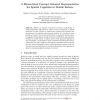Free Online Productivity Tools
i2Speak
i2Symbol
i2OCR
iTex2Img
iWeb2Print
iWeb2Shot
i2Type
iPdf2Split
iPdf2Merge
i2Bopomofo
i2Arabic
i2Style
i2Image
i2PDF
iLatex2Rtf
Sci2ools
AI50
2006
2006
A Hierarchical Concept Oriented Representation for Spatial Cognition in Mobile Robots
Robots are rapidly evolving from factory work-horses to robot-companions. The future of robots, as our companions, is highly dependent on their abilities to understand, interpret and represent the environment in an efficient and consistent fashion, in a way that is compatible to humans. The work presented here is oriented in this direction. It suggests a hierarchical, concept oriented, probabilistic representation of space for mobile robots. A salient aspect of the proposed approach is that it is holistic - it attempts to create a consistent link from the sensory information the robot acquires to the human-compatible spatial concepts that the robot subsequently forms, while taking into account both uncertainty and incompleteness of perceived information. The approach is aimed at increasing spatial awareness in robots.
AI50 2006 | Artificial Intelligence | Consistent Fashion | Human-compatible Spatial Concepts | Robot |
| Added | 20 Aug 2010 |
| Updated | 20 Aug 2010 |
| Type | Conference |
| Year | 2006 |
| Where | AI50 |
| Authors | Shrihari Vasudevan, Stefan Gächter, Ahad Harati, Roland Siegwart |
Comments (0)

